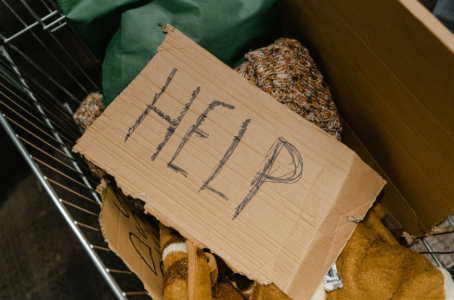This working Aussie went from paying $1200 a week in rent to living in a tent
As we all know too well, the cost of living has skyrocketed over the past few years. Soaring house prices and a lack of affordable accommodation have made the once straightforward task of finding a place to call home a daunting challenge.
A heartbreaking story recently emerged of a woman, who was once paying $1200 a week in rent, and is now forced to live in a tent due to Sydney's housing crisis.
Meet Kerry, a woman in her 30s who, just a year ago, enjoyed living in a two-bedroom apartment in trendy Waterloo. The former administration worker, now working as a jeweller, was paying a considerable sum of $1200 a week for her inner-city pad. Unfortunately, faced with a bout of illness and the subsequent medical expenses, Kerry found herself unable to keep up with the rent and rapidly spiralled into homelessness.

Sharing her story, she revealed she first thought she would be on the streets for just a couple of weeks, but the reality turned out far worse. With no viable alternative, Kerry now calls a tent in Enmore Park home.
Kerry reflects on her circumstances, noting her initial perception of homelessness as being associated with 'someone with a cardboard placard’. The stark truth is that Kerry is not alone; she's part of a growing sector deemed the 'working homeless' – people who hold jobs but still can't afford suitable housing due to a lack of supply and skyrocketing rental costs.
Australia's current housing crisis has been labelled its worst by Mission Australia CEO Sharon Callister, who asserts, 'We have an absolute housing emergency on our hands.'
The report by Mission Australia, 'A Safe Place to Call Home,' published on Tuesday, found a staggering 26 per cent increase in demand for their services over the last three years. Ms Callister stated that there has been a 50 per cent jump in people seeking help after becoming homeless, as opposed to when they were at risk.
Mission Australia is now urgently appealing to the country's state and federal governments to provide greater investment to tackle this unprecedented crisis. With a projected need for one million new social and affordable homes within the next 20 years, the charity hopes to ensure that everyone seeking help can find a safe place to call home.
The Australian Government has taken several steps towards relieving the crisis, from implementing better tenant protection laws to increasing funding for housing assistance. However, the current efforts are clearly still insufficient and neglect to address the root causes of the issue.
There is a need for increased funding for social and affordable housing over the next few decades, as well as strong support for initiatives that tackle homelessness. This can range from enhancements to homelessness services to greater access to rental and low-income housing for all Australians.
Australia should strive to establish long-term and sustainable solutions for the housing crisis, including increasing the supply of affordable housing, providing adequate rent assistance for those living in precarious situations, and ensuring that housing policies work in harmony with other social services in order to foster economic and social inclusion.
 Members, this harrowing tale is, unfortunately, becoming more common, and it's crucial to raise awareness of the issue and continue advocating for affordable housing and support services. No one should have to live in such uncertainty.
Members, this harrowing tale is, unfortunately, becoming more common, and it's crucial to raise awareness of the issue and continue advocating for affordable housing and support services. No one should have to live in such uncertainty.
Do you have any stories or valuable insights to share on the topic? We welcome your experiences and thoughts. Let's come together to explore possible solutions and lend a helping hand to those in need.
A heartbreaking story recently emerged of a woman, who was once paying $1200 a week in rent, and is now forced to live in a tent due to Sydney's housing crisis.
Meet Kerry, a woman in her 30s who, just a year ago, enjoyed living in a two-bedroom apartment in trendy Waterloo. The former administration worker, now working as a jeweller, was paying a considerable sum of $1200 a week for her inner-city pad. Unfortunately, faced with a bout of illness and the subsequent medical expenses, Kerry found herself unable to keep up with the rent and rapidly spiralled into homelessness.

Despite Kerry's employment, she continues to struggle with affording rent in Sydney. Photo by MART PRODUCTION
Sharing her story, she revealed she first thought she would be on the streets for just a couple of weeks, but the reality turned out far worse. With no viable alternative, Kerry now calls a tent in Enmore Park home.
Kerry reflects on her circumstances, noting her initial perception of homelessness as being associated with 'someone with a cardboard placard’. The stark truth is that Kerry is not alone; she's part of a growing sector deemed the 'working homeless' – people who hold jobs but still can't afford suitable housing due to a lack of supply and skyrocketing rental costs.
Australia's current housing crisis has been labelled its worst by Mission Australia CEO Sharon Callister, who asserts, 'We have an absolute housing emergency on our hands.'
The report by Mission Australia, 'A Safe Place to Call Home,' published on Tuesday, found a staggering 26 per cent increase in demand for their services over the last three years. Ms Callister stated that there has been a 50 per cent jump in people seeking help after becoming homeless, as opposed to when they were at risk.
Mission Australia is now urgently appealing to the country's state and federal governments to provide greater investment to tackle this unprecedented crisis. With a projected need for one million new social and affordable homes within the next 20 years, the charity hopes to ensure that everyone seeking help can find a safe place to call home.
The Role of Government in Addressing the Housing Crisis
The government needs to play an active role in addressing the problem and recognise the need for increased investment in social and affordable housing in order to ensure that all Australians have access to safe and secure housing.The Australian Government has taken several steps towards relieving the crisis, from implementing better tenant protection laws to increasing funding for housing assistance. However, the current efforts are clearly still insufficient and neglect to address the root causes of the issue.
There is a need for increased funding for social and affordable housing over the next few decades, as well as strong support for initiatives that tackle homelessness. This can range from enhancements to homelessness services to greater access to rental and low-income housing for all Australians.
Australia should strive to establish long-term and sustainable solutions for the housing crisis, including increasing the supply of affordable housing, providing adequate rent assistance for those living in precarious situations, and ensuring that housing policies work in harmony with other social services in order to foster economic and social inclusion.
Key Takeaways
- A woman named Kerry, who was living in a two-bedroom apartment in Sydney and paying $1200 a week, suddenly became homeless due to the city's housing crisis.
- Kerry represents the growing 'working homeless' population, as she is now unable to afford suitable housing despite holding a job as a jeweller.
- The share of rental properties listed for under $400 a week in Sydney has fallen to a record low of 9 per cent, while emergency accommodation and homelessness are increasing.
- Mission Australia is urging governments to invest in one million new social and affordable homes over 20 years to address the issue as the country faces a housing emergency.
Do you have any stories or valuable insights to share on the topic? We welcome your experiences and thoughts. Let's come together to explore possible solutions and lend a helping hand to those in need.







